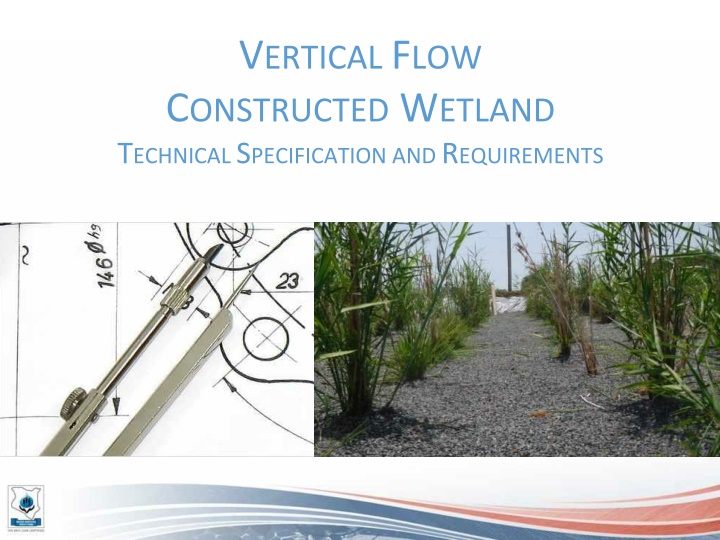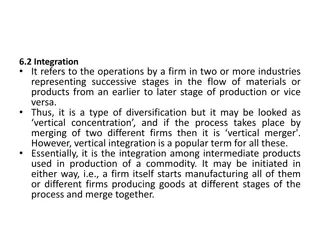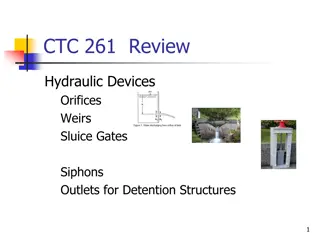Vertical Flow Constructed Wetland Technical Specifications and Requirements
The technical specifications for a vertical flow constructed wetland include requirements for subsurface compacting, lining materials such as clay layers and plastic liners, perforation of pipes, watertight installation of underdrain pipes, central drainage channel design, and filter media composition. Proper construction procedures are detailed to ensure effective water treatment and filtration in vertical flow wetland systems.
Uploaded on Sep 06, 2024 | 1 Views
Download Presentation

Please find below an Image/Link to download the presentation.
The content on the website is provided AS IS for your information and personal use only. It may not be sold, licensed, or shared on other websites without obtaining consent from the author.If you encounter any issues during the download, it is possible that the publisher has removed the file from their server.
You are allowed to download the files provided on this website for personal or commercial use, subject to the condition that they are used lawfully. All files are the property of their respective owners.
The content on the website is provided AS IS for your information and personal use only. It may not be sold, licensed, or shared on other websites without obtaining consent from the author.
E N D
Presentation Transcript
VERTICAL FLOW CONSTRUCTED WETLAND TECHNICAL SPECIFICATION AND REQUIREMENTS
SUBSURFACE Compact the subgrade (below the filter media) uniformly A slope of 1% toward the drainage channel is recommended for proper drainage 15 cm freeboard for water accumulation The surface must be flat and horizontal to prevent unequal distribution and surface run-off Gradient 1% Gradient 1% 15 cm
LINING MATERIAL A clay layer + Plastic liner to seal the filter bed at the base Clay layer of 100 mm thickness, if no clay available, the soil can be mixed with cement (8kg/m2) Preparation of the subgrade is crucial for successful liner installation: well compacted, free from materials that might puncture the liner PE liner 1 mm thick Overlapping 5 to 10 cm welded with wedge / hot air welding machine Before filling with gravel, water tightness test of the filter beds
PERFORATION OF PIPES Feeding pipes: uPVC class E (100, 60 and 40 mm dia.) Underdrain pipes: uPVC class 41 (100 mm dia)
WATERTIGHT INSTALLATION OF UNDERDRAIN PIPES To prevent leakages at the joint between the drainage pipes and the PE liner: Welding/glueing and fix with brackets Bitumen sealant
CENTRAL DRAINAGE CHANNEL PCC (with steel frame) or iron cast cover with two handles per cover. Dimension: 700 x 400mm Edge of the channel with recess
FILTER MEDIA The gravel layers do not contribute to filtering process. The middle sand layer is the actual filter bed. Sand should be of uniform grain size: d10 between 0.1 and 0.4 mm The sand filter bed should not contain loam, silt nor other fine material that could block the void The gravel at the base should not have sharp edges The layers of different size of substrate to be filled should be properly marked inside the basin
SAND SUITABILITY TEST Place a 300 mm long length of 110 mm dia. PVC pipe on a bed of gravel for free draining Fill it with 200 mm of the sand to be tested Place a piece of scouring pad on top to reduce disturbance by the water Pour 500 ml of water into the tube several time until the sand is completely damp (not saturated). The time for the water to drain from top to bottom should level off. Sands that drain in 50 150 seconds for 500 ml (once saturated) are satisfactory.
PLANTS The plant chosen should follow the following criteria: Indigenous (can be found locally) Deep root penetration, strong rhizomes and massive fibrous root Maximum surface area coverage (high biomass and stem density) Common Reed Overview of some possible plants: Phragmis australis or Phragmites karka (Common Reed) Typha latifolia or Typha angustifolia (Cattail) Pennisetum purpureum (Elephant grass) Cyperus papyrus (Papyrus sedge) Cattail Papyrus sedge Root and rhizome system of reed Elephant Grass























